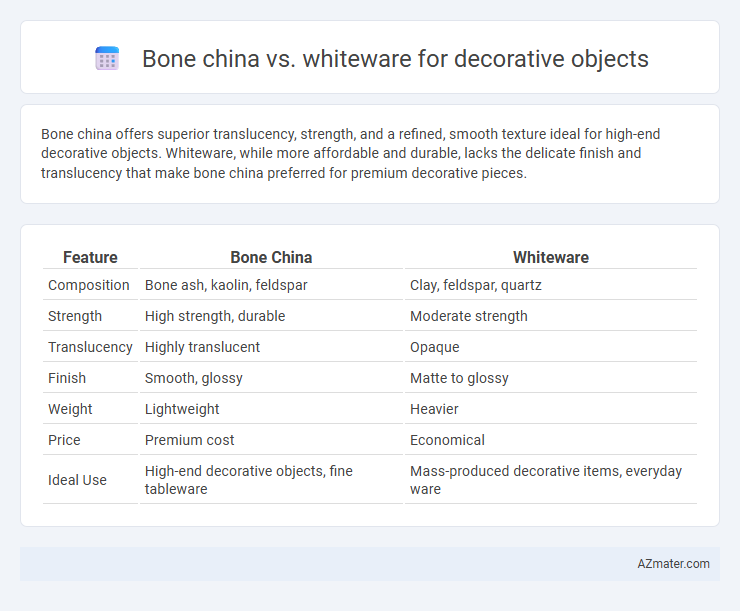Bone china offers superior translucency, strength, and a refined, smooth texture ideal for high-end decorative objects. Whiteware, while more affordable and durable, lacks the delicate finish and translucency that make bone china preferred for premium decorative pieces.
Table of Comparison
| Feature | Bone China | Whiteware |
|---|---|---|
| Composition | Bone ash, kaolin, feldspar | Clay, feldspar, quartz |
| Strength | High strength, durable | Moderate strength |
| Translucency | Highly translucent | Opaque |
| Finish | Smooth, glossy | Matte to glossy |
| Weight | Lightweight | Heavier |
| Price | Premium cost | Economical |
| Ideal Use | High-end decorative objects, fine tableware | Mass-produced decorative items, everyday ware |
Overview: Bone China vs Whiteware
Bone china offers superior translucency, strength, and a smooth, delicate finish, making it ideal for high-end decorative objects. Whiteware, composed of earthenware, stoneware, or porcelain, provides greater durability and affordability but lacks the refined translucence and lightness of bone china. Both materials suit decorative purposes, yet bone china is favored for luxury aesthetics, while whiteware appeals for robustness and cost-effectiveness.
Key Material Differences
Bone china contains bone ash, feldspar, and kaolin, resulting in a translucent, lightweight, and highly durable material ideal for fine decorative objects. Whiteware is typically made from earthenware or porcelain clay, fired at lower temperatures, producing a heavier, more opaque, and less chip-resistant surface. The bone ash in bone china enhances both whiteness and strength, making it superior for delicate, high-quality decorative items compared to the more porous and less refined whiteware.
Strength and Durability Comparison
Bone china offers superior strength and durability compared to whiteware due to its high bone ash content, which provides enhanced chip resistance and a finer, more vitrified structure. Whiteware, typically made from kaolin and other clays, tends to be more porous and brittle, making it less resistant to mechanical stress and prone to chipping or cracking under impact. The dense composition of bone china ensures longer-lasting decorative objects ideal for high-use display or delicate environments, whereas whiteware may require more careful handling.
Aesthetic Appeal and Finish
Bone china offers a translucent, smooth finish with a refined glaze that enhances the elegance of decorative objects, making it highly prized for its delicate aesthetic appeal. Whiteware, typically more opaque and sturdier, provides a matte or glazed surface that supports vibrant, lasting colors but lacks the subtle translucency of bone china. The choice between bone china and whiteware ultimately depends on the desired balance of delicate beauty versus durability in decorative pieces.
Translucency and Light Interaction
Bone china exhibits superior translucency compared to whiteware, allowing light to pass through its thin structure and creating a delicate, luminous effect ideal for decorative objects. Whiteware is more opaque, reflecting light on its surface rather than transmitting it, resulting in a more solid and less radiant appearance. The enhanced light interaction of bone china enhances the visual depth and elegance of ornamental pieces, making it preferable for designs emphasizing light play and refinement.
Suitability for Intricate Designs
Bone china offers superior translucency and a finer, smoother surface, making it ideal for intricate designs in decorative objects due to its ability to capture delicate details with high precision. Whiteware, while durable and less expensive, has a coarser texture that may limit the sharpness and refinement achievable in complex patterns. For artists and manufacturers prioritizing detailed craftsmanship, bone china is often preferred for its aesthetic qualities and enhanced suitability for elaborate decoration.
Cost Considerations
Bone china generally incurs higher production costs due to the inclusion of bone ash and longer firing times, leading to increased prices for decorative objects. Whiteware, composed primarily of kaolin and feldspar, offers a more affordable option with lower material and manufacturing expenses. Choosing between bone china and whiteware for decorative items depends on budget constraints and the desired balance between quality and cost.
Maintenance and Longevity
Bone china offers superior durability and resistance to chipping compared to whiteware, making it ideal for long-lasting decorative objects. Whiteware, though more affordable, is more porous and prone to cracking or staining over time, requiring careful handling and cleaning. Maintenance for bone china typically involves gentle washing and avoiding abrasive materials to preserve its translucency and finish.
Popular Uses in Decorative Objects
Bone china is highly favored for decorative objects such as fine figurines, vases, and ornate tableware due to its translucent quality, smooth texture, and durability. Whiteware, including earthenware, stoneware, and porcelain, is commonly used for decorative tiles, garden ornaments, and rustic-style ceramics because of its versatility and cost-effectiveness. Collectors and designers often choose bone china for luxury decor items, while whiteware suits both functional and ornamental purposes in various interior design styles.
Choosing the Best Option for Your Decor
Bone china offers exceptional translucency and a smooth, elegant finish ideal for high-end decorative objects, while whiteware provides a durable and more affordable alternative with versatile glazing options. Choosing the best option depends on the desired aesthetic, budget, and durability requirements; bone china suits refined, delicate decor, whereas whiteware fits casual or outdoor settings. Consider factors like translucence, strength, and cost to select the perfect ceramic material for your decorative needs.

Infographic: Bone china vs Whiteware for Decorative object
 azmater.com
azmater.com